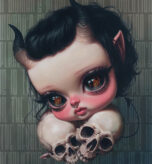Art has always been more than just an aesthetic expression—it’s a form of communication, a tool for connection, and a mirror of the world we live in. As an artist, I’m driven by the desire to create work that doesn’t just capture beauty, but also reflects the diversity of human experience. For me, representation in art isn’t just important—it’s essential.
The Power of Feeling Seen
There’s something powerful about seeing yourself reflected in art. Whether it’s a character who shares your skin tone, your culture, or your story, that representation fosters a sense of belonging. I want people to feel seen—not just because they recognize an aesthetic, but because they connect with the deeper messages of acceptance and empathy woven into my work.
Historically, art has skewed heavily towards Caucasian depictions, with many other groups underrepresented in traditional media. This is true in classical art, modern media, and even in the early stages of AI-generated art. For example, when I began exploring AI tools like Midjourney, I noticed that the algorithms had trouble accurately representing darker skin tones. At first, it was frustrating, but I realized that this was due to a lack of diversity in the data sets AI was trained on.
Just like any tool, AI can only reflect the data it’s been fed. The more diverse images and prompts we create, the more inclusive these data sets will become. In many ways, artists working with AI have an opportunity—and a responsibility—to “teach” the AI that there are a multitude of skin tones, physical characteristics, races, religions, and stories that need to be represented. Every time we create, we contribute to a richer, more inclusive dataset, making future representations more accurate and diverse.
An Eye-Opening Moment: The Little Mermaid
One moment that deeply affected me was when I saw a video compilation of young African American girls watching the trailer for the live-action The Little Mermaid movie. Ariel, played by an African American actress, sparked a wave of excitement in these children. One little girl squealed with delight, saying, “She looks like me!”
As a Caucasian woman, I’ve never had to think about representation in that way. Growing up, I always saw characters who looked like me in movies, books, and art. That video opened my eyes to how immensely important it is for everyone to feel represented. It touched me to the core, and from that moment on, I’ve made it a personal mission to ensure that the characters I create reflect the wide spectrum of humanity.
Representation Isn’t Just About Identity
When we talk about representation in art, it goes beyond race, gender, or sexuality. It’s about reflecting a range of experiences, stories, and ideas. In my work, I strive to feature characters that are not traditionally seen in mainstream art. Whether it’s creating African American characters that challenge stereotypical depictions or bringing visibility to LGBTQIA+ stories, I’m constantly working to highlight perspectives that are often overlooked.
For me, it’s not just about checking a box. It’s about genuinely contributing to a world where people feel seen, accepted, and valued for who they are. When someone looks at my art, I want them to feel connected to the work, to feel that they belong.
Art as a Catalyst for Change
Representation in art has the power to create change—not just on a personal level, but on a societal one. Art can challenge perceptions, break down stereotypes, and open our minds to new ways of thinking. By showcasing underrepresented voices, we allow for a more complete narrative of what it means to be human.
This is where technology and art intersect in meaningful ways. AI has given me the ability to create even more diverse representations in my work. While it’s far from perfect, AI tools like Midjourney allow me to push the boundaries of what’s possible in visual art. But it’s my human experience, empathy, and desire for connection that guide the process. The more I use these tools, the more I can contribute to making the technology itself more inclusive.
Why It Matters More Than Ever
In today’s world, where people are constantly fighting for visibility and equality, representation in art is more important than ever. Art is a platform that can amplify voices, challenge societal norms, and foster empathy. As artists, we have the ability—and the responsibility—to reflect the world as it truly is: diverse, multifaceted, and beautifully imperfect.
When someone looks at my art, I want them to feel seen, accepted, and valued. I want to create spaces where people of all backgrounds and experiences can find themselves and know that they belong. Representation matters because every human deserves to be seen for who they truly are, and art has the power to make that happen.





